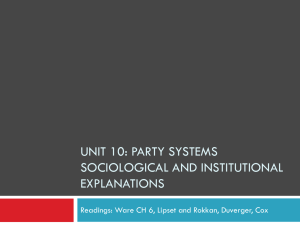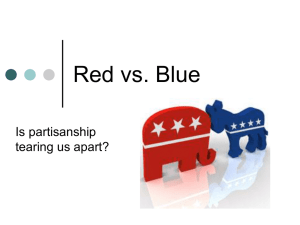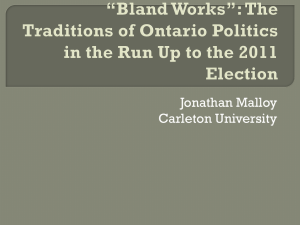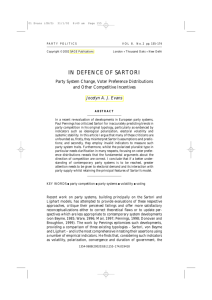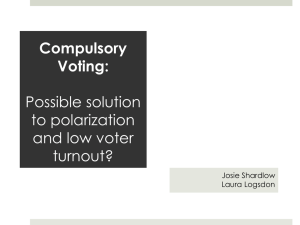Unit 9: Party Systems (Competition)
advertisement
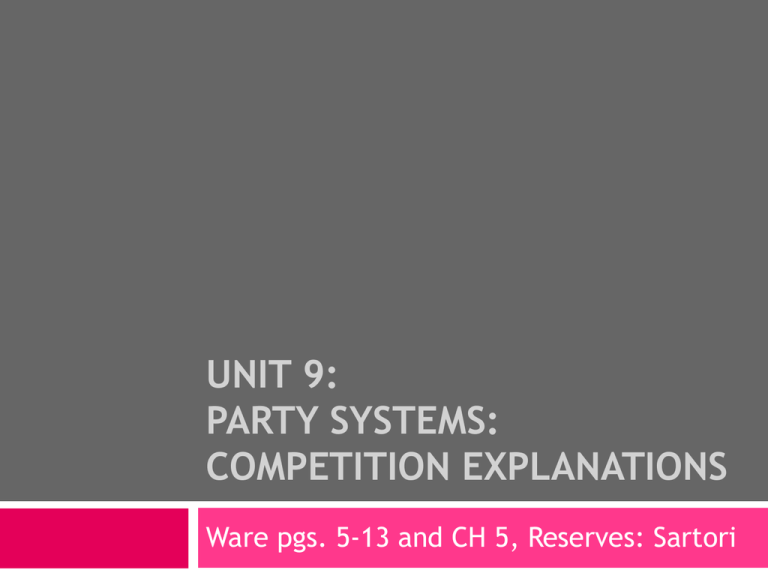
UNIT 9: PARTY SYSTEMS: COMPETITION EXPLANATIONS Ware pgs. 5-13 and CH 5, Reserves: Sartori Reading Note Party Systems: Competition The library will not place Sartori on electronic reserves due to copyright restrictions The reading is available on hard reserves at Geisel. Page numbers are listed on the reading handout on course website. Party Systems: Sociological and Institutional The library will not place Lipset and Rokkan or Duverger on electronic reserves due to copyright restrictions An abridged version of Lipset and Rokkan can be accessed at: http://www.janda.org/c24/Readings/Lipset&Rokkan/Lipset&Rok kan.htm An abridged version of Duverger can be accessed at: http://www.janda.org/c24/Readings/Duverger/Duverger.htm Guiding Questions What are party systems? How do we characterize/explain party systems? Why do we study party systems? Which variables do competition theories privilege? How do we evaluate competition theories of party systems? Party Systems Defined Ware 1996 Units: political parties Systems: “patterns of competition and co-operation between the different parties [within a given] system” Why Do We Care? It was believed that the number of parties within a system exerted a large influence on party behavior. Also argued that democratic stability was predicated on the number of parties within a system. Two party systems promote moderation. Examples: French Third and Fourth Republics, Italian First Republic, Weimar Germany. But the number of political parties within the system only tells us part of the story. These cases also had other factors which promoted instability. Multiparty systems are not necessarily less moderate than two party systems. Two party systems are not necessarily more moderate than multiparty systems. Why Do We Care? Understanding the party system gives us a basic understanding of the political system. Knowing the number (and types) of parties present within a system provides a basis for analysis and comparison with other systems. An “entry level” discussion of a political system. Are there anti-system parties? How polarized is the political system? Understanding party systems helps us to identify whether or not broad political change is occurring. Are the “old guard” parties holding their own? Are new movements eclipsing the older parties? What Shapes Party Systems? DV: Party systems Competition theories (e.g. Sartori 1976) IV: Sociological theories (e.g. Lipset and Rokkan 1967) IV: patterns of political competition social divisions/cleavage patterns Institutional theories (e.g. Duverger 1951; 1954). IV: electoral systems; number of parties Competition Theories: Fragmentation Sartori 1976 Number of parties (fragmentation) shapes complexity of the system. But this begs the question: Which parties should be counted? Parties are relevant if they possess: Coalition potential Blackmail potential Competition: Polarization Sartori 1976 Fragmentation only tells us part of the story. Ideological spread of relevant parties (polarization) also matters. Classifies party systems on the basis of fragmentation (number of parties) and polarization (ideological spread and intensity). Identifies seven categories. Multiparty Systems: Polarized Pluralism Sartori 1976 Fragmentation: Five to six relevant political parties. Polarization: Center of spectrum is occupied. Relevant anti-system parties exist. Patterns of competition: Centrifugal Polarization creates center fleeing effects. Consequences for the party system: Bilateral oppositions force coalitions of the center. Ideological patterning, irresponsible oppositions, and a politics of outbidding. Example: Weimar Republic; Italian First Republic Multiparty Systems: Moderate Pluralism Sartori 1976 Fragmentation: Polarization: Centripetal Lack of polarization creates center seeking effects. Consequences for the party system: Center of spectrum is not occupied. No anti-system parties or bilateral oppositions Patterns of Competition: 3-5 parties exist Bipolar coalition structure; alternation in government occurs. Example: Italian Second Republic amongst others. Two Party Systems Sartori 1976 Fragmentation: Polarization: Two parties can conceivably win a majority of the seats. One of the two parties always win a parliamentary majority. Consequences for the party competition No anti system parties Pattern of competition: Two parties Majority party is willing to govern alone. Alternation of government is expected or possible Example: United States; United Kingdom (2.5 parties) Predominant Party Systems Sartori 1976 Fragmentation: Polarization: No anti-system parties System allows for other parties to exist and contest elections. Consequences for the party system: Pluralist systems with more than one relevant party. Three consecutive majority governments create a predominant system. Alternation does not occur in these systems. Same party consistently (and legally) wins the majority of seats. Example: South Africa Hegemonic/One Party Systems Sartori 1976 Fragmentation: One party dominates the system. Polarization: Not pluralist. Other parties are denied access to the political system. Consequences for the party system: Limited competition and access to the political system. Example: Former Soviet Union; China Evaluating Sartori STRENGTHS Useful in terms of determining relevant political parties. Appear to be links between the number of political parties within a system and its polarization. Pattern of competition does appear to shape coalition formation. WEAKNESSES Classification lumps most systems into the moderate pluralist category. Extreme parties, whether or not anti-system, may create centrifugal tendencies. Appeals in two party systems are not always moderate. Sociological and Institutional Rejoinders Sartori hints at aspects of society that foster moderate politics. Boosts sociological explanations. Discussion glosses over how institutions frame competition within the system. Suggests Is that institutional explanations are relevant. competition epiphenomenal? Next Unit Theme: Party Systems-Sociological and Institutional Explanations Readings: Ware CH 6 Reserves (Lipset and Rokkan, Duverger, Cox)
